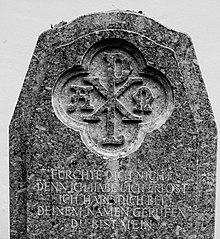Christ monogram



The Christ monogram consists of the two Greek letters Χ ( Chi , spoken: ch ) and Ρ ( Rho , spoken: r ), written on top of each other , roughly in the following form: ☧ . It is also called Chi-Rho or Constantine Cross , earlier also Christogram . These are the first two letters of the Greek word Χρ ιστός Christós ( Christ ). After the cross and the fish , it is the most common symbol for Jesus Christ . It has been known since the 2nd century AD, making it one of the oldest Christian emblems ( symbols ) - even before the cross. Christians use it to show their faith in Jesus Christ and to recognize one another.
history
The Christ monogram became the earliest Christian symbol because the ligature ΧΡ connects the first two letters of the word Χριστός Christos ; so it is the abbreviation of the title Christ (anointed) , in Hebrew Maschiach , Messiah . It was particularly widespread in late antiquity . The similarity of the Greek letters Χ (Chi) and Ρ (Rho) with the Latin letters X and P prompted the interpretation of the symbol as a short form of the Latin Pax (peace) or Pax Christi . It expressed that Christ gives peace and that Christians should strive for peace.
Constantine the Great is said to have ordered his army to paint it on the shields and on the newly introduced Labarum , according to a vision in which he was told “ In this sign you will conquer ” . This happened either before the decisive battle against Maxentius at the Milvian Bridge in 312 or before the decisive battle against Licinius at Chrysopolis .
Related Christ symbols
Another, much later abbreviation for Jesus Christ is the noun sacrum IHS . It consists of the sequence of letters ( transcription ) of the first two Greek letters Iota , Eta and the last letter Sigma of the name "Jesus". When the depiction of crucifixes came up, INRI also became popular. This is the abbreviation for Iesus Nazarenus Rex Iudaeorum (German: "Jesus of Nazaret, King of the Jews") and is said to have stood in three languages (Hebrew, Greek, Latin) on a sign, which Pontius Pilate according to Joh 19,19f EU on The cross of Christ.
The Unicode symbol of the Christ monogram is U + 2627: ☧.
See also
Web links
Individual evidence
- ↑ Manfred Clauss : Konstantin I. In: Manfred Clauss (Ed.): The Roman Emperors. 55 historical portraits from Caesar to Justinian. Beck, Munich 1997, ISBN 3-406-42727-8 , pp. 282-305, here p. 286.
- ^ Eva Lüders: About the Abbreviation of Jesus Christ in the medieval manuscripts. In: Studia neophilologica 43, 1971, p. 375 f.